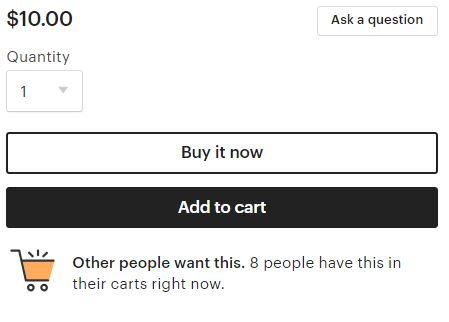You know you want to promote your company; you know you want to attract customers; you know you want to make a sale. And you’ve probably read a lot of advice about how to do all those things. There’s an art to making sales and of course you need to master it. But to become part of a customer’s life, you need to get inside their brain, first.
Knowing the psychology behind what triggers someone to buy is a big leg up. Maybe it seems unnecessary – but the truth is, the more you understand why people are reacting, even at a mental level, the more you can predict how they will react to your product.
Understanding how people make purchasing decisions can give you the tools to encourage them to buy. It’s not about tricking people: it’s about becoming what they’re already looking for.
You don’t need a Ph.D for this – we’re here to break it down for you. Here’s a list of tools to utilize the psychology of selling, and increase sales:
Emotion
You’ve probably heard this marketing adage: people buy with emotions but justify with logic. Well, it’s an adage because it’s true: emotion is a powerful tool. Our emotional decisions are based on our unconscious mind, which is able to process millions of data pieces without being overwhelmed – you can subconsciously arrive at a decision, based on emotion, without taking too long to think about it. We see that cinnamon bun and we just gotta eat it. But our conscious mind – where we make logical decisions – can only process three or four new pieces of info at a time.
 We see a cinnamon bun and think, My New Year resolution was to eat healthier; how many calories are in that? But I’ve been eating really well this week, I can get a treat. Well, how much does it cost? Seven dollars for one bun? Well, it’s a specialty dessert shop; but that’s pretty expensive… Suddenly, we need justifications for that emotional decision. And if there are too many justifications or qualifications to process, our conscious brain gets overwhelmed – a cinnamon bun isn’t worth the stress the decision is causing.
We see a cinnamon bun and think, My New Year resolution was to eat healthier; how many calories are in that? But I’ve been eating really well this week, I can get a treat. Well, how much does it cost? Seven dollars for one bun? Well, it’s a specialty dessert shop; but that’s pretty expensive… Suddenly, we need justifications for that emotional decision. And if there are too many justifications or qualifications to process, our conscious brain gets overwhelmed – a cinnamon bun isn’t worth the stress the decision is causing.
Knowing that consumers are being urged by their emotions first, your business can capitalize on an emotional appeal and make sure there are enough logical justifications to back up the decision after a consumer’s conscious/logical brain kicks in. If you know we want a cinnamon bun at the emotional level, maybe add a promotion: “buy one bun, get the second bun 50% off”. Or write a sign that says, “You’ve worked hard – you deserve dessert.” Small steps that can be the tipping point the conscious mind needs to justify the unconscious mind’s decision.

Playing to the Ego
People want to feel good about themselves; if their purchase can fulfill that want, then they will happily buy. The psychology behind this is the need for validation, which is how we communicate acceptance of ourselves, others, and societal norms. Show that your product can validate their ego. Consumers think, “What’s in it for me?” That’s not a bad thing: it’s a natural human response. We generally want to correlate our self-image with
Somehow, if what they’re buying is helping them keep a promise; meet a resolution; validating a trait; making their life better; donating to charity; giving them bragging rights; keeping them on trend – ooh boy, look at those uptick in sales. Remember that when consumers are considering your product, they’re asking themselves, “what’s in it for me?”.
Continually Showing Improvement
What’s the new product you’re delivering on? Did you fix that bug? Have you responded to concerns? How are you upping your game each quarter? 
Or…is your product or brand exactly the same as when you started, no matter how much time has passed?
The urge to progress is a primal psychological force that has driven humans forward for millennia. It’s so hardwired in us – think, “survival of the fittest” – that we look for that trait in everything around us. We are impressed when we recognize progression and improvement because we psychologically understand that this represents fitness, longevity, and trustworthiness.
People respond to improvement: it increases credibility and trust. When you show improvement – either through better product or fixes to current ones – they believe that you’ll deliver on promises and listen to concerns. Consumers want to interact with a company that does both.
Human Touch
Think about how frustrated people are when they call customer service, are on the phone with a robot for 45 minutes, and end up yelling, REPRESENTATIVE at an A.I. system.
It’s hard to believe “your call is very important to us” when a real person from the company can’t take the time to listen. An Invoca survey found that 74% of people who have a bad customer service experience on the phone will choose a different company the next time they shop for a product or service. And according to another survey by IMShopping, 77% of online shoppers wish they could talk to a live person before buying.
According to Peter DeHaan, CEO of a print media publishing company: “The human touch elevates customer satisfaction over cost savings, and is in the best interest of your company”. Even if automated representatives are cost-efficient, letting your customers connect with a real human increase your likelihood of making a sale. Real humans can respond to specific requests, answer complex questions, and empathize with your customers’ feelings. And empathy, like emotion, is another powerful tool for the psychology of sales.
People buy from people. You’re selling you, your team, and your reviewers.

Limited Edition
In a free market economy: if there’s a desired good that’s running out of supply, that’s an indicator that there’s high demand for it – and that means you should want it, too. It’s a combination of mob mentality and scarcity principle and FOMO.
Scarcity drives demand of a valued good. If a consumer is on the fence about buying your product, then a last psychological push they may need is a “sold out” mentality. Thinking that what they want is almost sold out makes them scared to miss their chance. A similar effect is caused with a “limited edition” or “limited time offer” tactic.
The online marketplace Etsy utilizes the scarcity principle (“sold out” mentality) by listing how many other people have the item you want in their carts – giving the impression that if you don’t buy the item, one of those other people will, and you’ll lose your chance. They don’t need to directly say this; they just need to prey on a psychological fear of missing out.

Problem Solver
Sometimes asking consumers to imagine all the great things they’ll gain by buying your product is too hard. Instead, come to them with a list of proactive solutions. Don’t wait to see what they need and then react: tell them ahead of time that you’ll solve their specific problems if they become your customer.
In Conclusion:
You shouldn’t scoff at science in this situation – at least, not at behavioral science. Knowing why people buy will help you create marketing strategies that up your chances of making sales. Be sincere but also be strategic.
no credit required


